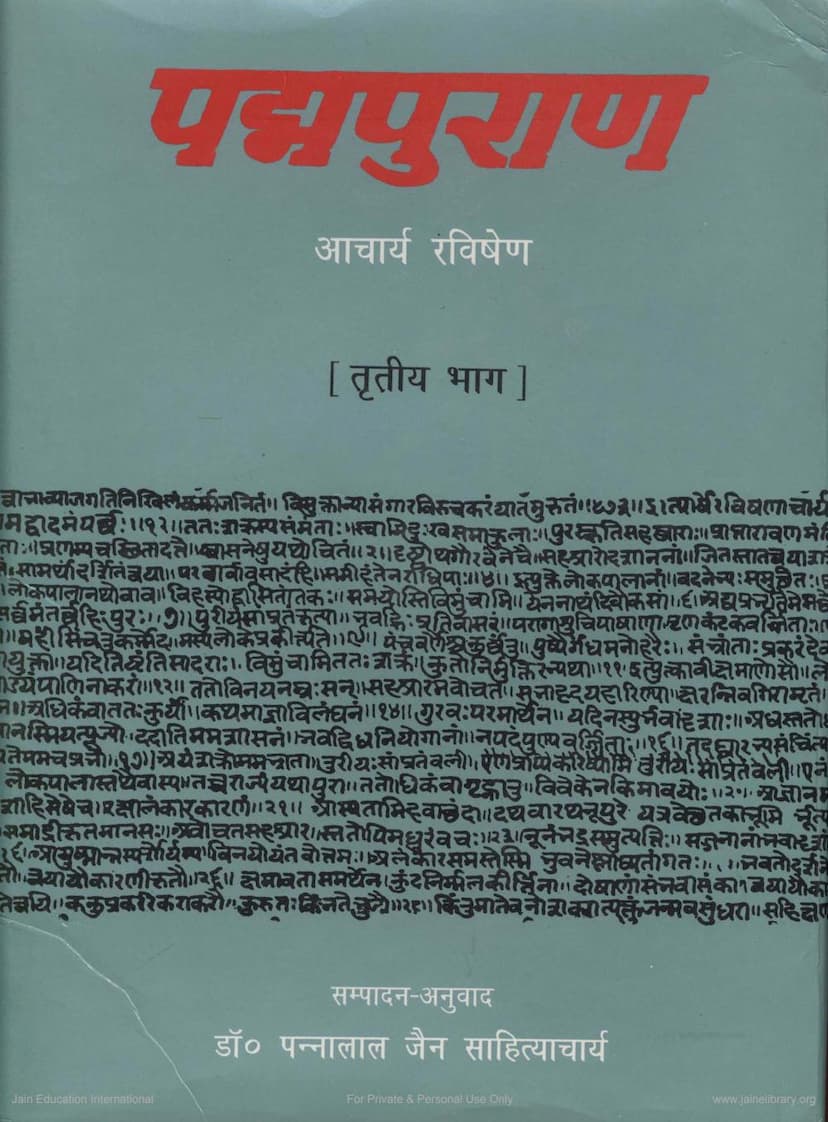Padmapuran Part 3
Added to library: September 2, 2025

Summary
Summary of Padmapuran, Part 3 by Raviṣeṇācārya (Edited and Translated by Dr. Pannalal Jain)
This summary covers the events described in Volume III of the Padmapuran, focusing on the latter part of Lord Rama's life and the subsequent developments within the Jain narrative tradition.
Key Themes and Events:
- The Pursuit of Power and Renunciation: The narrative continues to explore the consequences of desires and the paths of spiritual renunciation. Characters grapple with attachment to worldly power, wealth, and sensory pleasures.
- Consequences of Actions (Karma): The text consistently emphasizes the law of karma, illustrating how past actions influence present circumstances and future births. Even divine beings are subject to the consequences of their deeds.
- The Ideal Jain Ruler and Ascetic: The narrative portrays ideal Jain rulers and ascetics, highlighting virtues like righteousness, compassion, self-control, and unwavering devotion to Jain principles.
- Spiritual Journey and Liberation (Moksha): The ultimate goal remains liberation from the cycle of birth and death, achieved through rigorous asceticism, right faith, knowledge, and conduct.
- The Ramachandra Character: Within the Jain context, Rama is depicted as a virtuous and righteous ruler, embodying Jain ideals. His adherence to Dharma, even in challenging situations, is a central theme.
- The Role of Other Prominent Characters: The text elaborates on the stories and eventual spiritual paths of characters like Lakshmana, Bharata, Shatrughna, Ravana, Vibhishana, and Mandodari, often showcasing their karmic journeys.
- The Significance of Jain Temples and Practices: The importance of Jain temples, the worship of Tirthankaras, and adherence to various religious practices are woven into the narrative, emphasizing their role in spiritual progress.
Detailed Summary of Chapters (Paryavs):
The provided text outlines the content of chapters 66 through 107, detailing significant events in the lives of the characters and their spiritual journeys. Here's a breakdown of the key developments:
-
Chapters 66-75: These chapters focus on the unfolding conflict with Ravana. We witness negotiations, the deployment of armies, Ravana's attempts to gain mystical powers (Bahurupini Vidya), and the ensuing battles. The narrative highlights the valor of Lakshmana and other warriors, the strategic brilliance of Rama, and the eventual defeat and death of Ravana. The text also describes the subsequent mourning, funeral rites, and the initiation of several characters into monkhood. The interaction with various divine beings and the descriptions of their powers are also detailed.
-
Chapters 76-81: The focus shifts to the aftermath of the war and the subsequent events. We see the grief of Vibhishana, the funeral rites of Ravana, and the spiritual transformation of several characters, including Indrajit and Meghavahana. The narrative then details Rama and Lakshmana's return to Ayodhya, their reception, and the subsequent events in Ayodhya.
-
Chapters 82-88: These chapters delve into the lives of Bharata, Shatrughna, and their spiritual journeys. Bharata's detachment from worldly pleasures and his eventual renunciation are described. Shatrughna's conquest of Mathura and his subsequent spiritual inclinations are also mentioned. The text emphasizes the importance of righteous conduct and the pursuit of Dharma even amidst great power and prosperity.
-
Chapters 89-93: The narrative continues to explore the lives and actions of various characters. The obsession of Shatrughna with Mathura is explained through his past lives. The arrival of righteous ascetics in Mathura and the positive impact they have on the city are described. The marriages of Rama and Lakshmana are also detailed.
-
Chapters 94-96: These chapters focus on the lives and actions of Sita and her children, Lava and Kusha. Sita's profound devotion, her dreams, and her eventual abandonment due to public opinion are central to this section. The narrative explores the subsequent suffering of Sita and her eventual spiritual liberation. Rama's sorrow and eventual understanding of the consequences of his actions are also depicted.
-
Chapters 97-107: The final chapters in this volume cover a range of events. Lakshmana's heroic battles and his spiritual transformation are described. The coronation of Rama and Lakshmana and the subsequent division of kingdoms are detailed. The text then shifts to the stories of Hanuman, Sugriva, Vibhishana, and their respective spiritual paths. The narrative also recounts the birth and early life of Lava and Kusha, their eventual reunion with Rama, and their own spiritual journeys. The immense suffering caused by worldly attachments and the ultimate bliss of renunciation are recurring themes. The text concludes by emphasizing the importance of Jain teachings for achieving ultimate happiness and liberation.
Overall Significance:
Padmapuran Part 3, as part of the larger work, continues to present a comprehensive and intricate Jain version of the Ramayana narrative. It uses the familiar characters and plot points to illustrate core Jain philosophical concepts, particularly the law of karma, the pursuit of spiritual liberation through asceticism, and the importance of right faith, knowledge, and conduct. The text not only narrates the story but also serves as a didactic work, guiding readers towards a virtuous life and spiritual enlightenment.